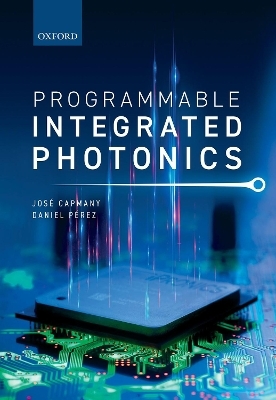
Programmable Integrated Photonics
Oxford University Press (Verlag)
978-0-19-884440-2 (ISBN)
This book provides the first comprehensive, up-to-date and self-contained introduction to the emergent field of Programmable Integrated Photonics (PIP). It covers both theoretical and practical aspects, ranging from basic technologies and the building of photonic component blocks, to design alternatives and principles of complex programmable photonic circuits, their limiting factors, techniques for characterization and performance monitoring/control, and their salient applications both in the classical as well as in the quantum information fields. The book concentrates and focuses mainly on the distinctive features of programmable photonics, as compared to more traditional ASPIC approaches.
After some years during which the Application Specific Photonic Integrated Circuit (ASPIC) paradigm completely dominated the field of integrated optics, there has been an increasing interest in PIP. The rising interest in PIP is justified by the surge in a number of emerging applications that call for true flexibility and reconfigurability, as well as low-cost, compact, and low-power consuming devices.
Programmable Integrated Photonics is a new paradigm that aims at designing common integrated optical hardware configurations, which by suitable programming, can implement a variety of functionalities. These in turn can be exploited as basic operations in many application fields. Programmability enables, by means of external control signals, both chip reconfiguration for multifunction operation, as well as chip stabilization against non-ideal operations due to fluctuations in environmental conditions and fabrication errors. Programming also allows for the activation of parts of the chip, which are not essential for the implementation of a given functionality, but can be of help in reducing noise levels through the diversion of undesired reflections.
José Capmany is Full Professor in Photonics and Optical Communications at the Universitat Politècnica de Valencia. He holds a PhD in Electrical Engineering from Universidad Politécnica de Madrid and a PhD in Quantum Physics from the Universidad de Vigo. He has published over 550 papers in international refereed journals and conferences. He was the general chair of the 41st European Conference on Optical Communications (ECOC) held in Valencia in 2015. He is a Fellow of the IEEE and the Optical Society of America (OSA), and is a founder and chief innovation officer of the spin-off company VLC Photonics (www.vlcphotonics.com ). He is the 2012 King James I Prize Laureate on novel technologies, the highest scientific distinction in Spain, for his outstanding contributions to the field of microwave photonics. In 2016 he was awarded a European Research Council (ERC) Advanced Grant. He is Editor-in-Chief of the IEEE Journal of Selected Topics in Quantum Electronics. Daniel Pérez received the BSc degree in telecommunications in 2014, the MSc degree in Telecommunication Technologies, Systems and Networks in 2015, and the PhD in 2017, all from the Universitat Politècnica de València (UPV). Pérez received the COIT-AEIT award as the Best Final Degree Project in Fundamentals and Information Technologies, Communications and its Applications in 2015, and recently the national award for the best thesis in the area of photonics. He has been involved in several research projects. He has published around 50 international publications as a researcher at the Photonics Research Labs (www.prl.upv.es) of the ITEAM Research Institute, UPV, where he is currently working as a Postdoctoral Research Fellow. He has been recognized with the 2017 IEEE Photonics Society Graduate Student Fellowship Award. His research embraces Microwave Photonics, focusing on integrated reconfigurable photonic processors.
1: Introduction
2: Basic Building Blocks
3: Reconfigurable Application Specific Photonic Integrated Circuits
4: Integrated Multiport Interferometers
5: Integrated Waveguide Meshes
6: Practical Implementation of programable photonic circuits
7: Applications in Quantum systems
8: Applications in Classical systems
9: Field Programmable Photonic Gate Arrays
| Erscheinungsdatum | 03.01.2020 |
|---|---|
| Zusatzinfo | 145 color line, 28 color half-tones, and 7 grayscale line figures |
| Verlagsort | Oxford |
| Sprache | englisch |
| Maße | 174 x 253 mm |
| Gewicht | 844 g |
| Themenwelt | Naturwissenschaften ► Physik / Astronomie ► Optik |
| Technik ► Elektrotechnik / Energietechnik | |
| ISBN-10 | 0-19-884440-9 / 0198844409 |
| ISBN-13 | 978-0-19-884440-2 / 9780198844402 |
| Zustand | Neuware |
| Haben Sie eine Frage zum Produkt? |
aus dem Bereich


